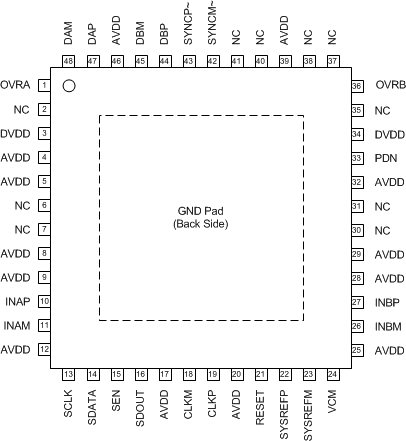SBAS668A May 2014 – June 2015 ADC32J22 , ADC32J23 , ADC32J24 , ADC32J25
PRODUCTION DATA.
- 1 Features
- 2 Applications
- 3 Description
- 4 Revision History
- 5 Device Comparison Table
- 6 Pin Configuration and Functions
-
7 Specifications
- 7.1 Absolute Maximum Ratings
- 7.2 ESD Ratings
- 7.3 Recommended Operating Conditions
- 7.4 Thermal Information
- 7.5 Electrical Characteristics
- 7.6 Electrical Characteristics: ADC32J22, ADC32J23
- 7.7 Electrical Characteristics: ADC32J24, ADC32J25
- 7.8 AC Performance: ADC32J25
- 7.9 AC Performance: ADC32J24
- 7.10 AC Performance: ADC32J23
- 7.11 AC Performance: ADC32J22
- 7.12 Digital Characteristics
- 7.13 Timing Requirements
- 7.14 Typical Characteristics: ADC32J25
- 7.15 Typical Characteristics: ADC32J24
- 7.16 Typical Characteristics: ADC32J23
- 7.17 Typical Characteristics: ADC32J22
- 7.18 Typical Characteristics: Common Plots
- 7.19 Typical Characteristics: Contour Plots
- 8 Parameter Measurement Information
-
9 Detailed Description
- 9.1 Overview
- 9.2 Functional Block Diagram
- 9.3 Feature Description
- 9.4 Device Functional Modes
- 9.5 Programming
- 9.6
Register Maps
- 9.6.1 Summary of Special Mode Registers
- 9.6.2
Serial Register Descriptions
- 9.6.2.1 Register 01h (address = 01h)
- 9.6.2.2 Register 03h (address = 03h)
- 9.6.2.3 Register 04h (address = 04h)
- 9.6.2.4 Register 06h (address = 06h)
- 9.6.2.5 Register 07h (address = 07h)
- 9.6.2.6 Register 08h (address = 08h)
- 9.6.2.7 Register 09h (address = 09h)
- 9.6.2.8 Register 0Ah (address = 0Ah)
- 9.6.2.9 Register 0Bh (address = 0Bh)
- 9.6.2.10 Register 0Ch (address = 0Ch)
- 9.6.2.11 Register 0Dh (address = 0Dh)
- 9.6.2.12 Register 0Eh (address = 0Eh)
- 9.6.2.13 Register 0Fh (address = 0Fh)
- 9.6.2.14 Register 13h (address = 13h)
- 9.6.2.15 Register 15h (address = 15h)
- 9.6.2.16 Register 27h (address = 27h)
- 9.6.2.17 Register 2Ah (address = 2Ah)
- 9.6.2.18 Register 2Bh (address = 2Bh)
- 9.6.2.19 Register 2Fh (address = 2Fh)
- 9.6.2.20 Register 30h (address = 30h)
- 9.6.2.21 Register 31h (address = 31h)
- 9.6.2.22 Register 34h (address = 34h)
- 9.6.2.23 Register 3Ah (address = 3Ah)
- 9.6.2.24 Register 3Bh (address = 3Bh)
- 9.6.2.25 Register 3Ch (address = 3Ch)
- 9.6.2.26 Register 422h (address = 422h)
- 9.6.2.27 Register 434h (address = 434h)
- 9.6.2.28 Register 522h (address = 522h)
- 9.6.2.29 Register 534 (address = 534h)
- 10Applications and Implementation
- 11Power Supply Recommendations
- 12Layout
- 13Device and Documentation Support
- 14Mechanical, Packaging, and Orderable Information
パッケージ・オプション
メカニカル・データ(パッケージ|ピン)
- RGZ|48
サーマルパッド・メカニカル・データ
- RGZ|48
発注情報
6 Pin Configuration and Functions
RGZ Package
48-Pin VQFN
Top View

Pin Functions
| PIN | I/O | DESCRIPTION | |
|---|---|---|---|
| NAME | NO. | ||
| AVDD | 4, 5, 8, 9, 12, 17, 20, 25, 28, 29, 32, 39, 46 | I | Analog 1.8-V power supply |
| CLKM | 18 | I | Negative differential clock input for the ADC |
| CLKP | 19 | I | Positive differential clock input for the ADC |
| DAM | 48 | O | Negative serial JESD204B output for channel A |
| DAP | 47 | O | Positive serial JESD204B output for channel A |
| DBM | 45 | O | Negative serial JESD204B output for channel B |
| DBP | 44 | O | Positive serial JESD204B output for channel B |
| DVDD | 3,34 | I | Digital 1.8-V power supply |
| GND | PowerPAD™ | I | Ground, 0 V |
| INAM | 11 | I | Negative differential analog input for channel A |
| INAP | 10 | I | Positive differential analog input for channel A |
| INBM | 26 | I | Negative differential analog input for channel B |
| INBP | 27 | I | Positive differential analog input for channel B |
| NC | 2, 6, 7, 30, 31, 35, 37, 38, 40, 41 | — | Do not connect |
| OVRA | 1 | O | Overrange indicator for channel A |
| OVRB | 36 | O | Overrange indicator for channel B |
| PDN | 33 | I | Power-down control. This pin has an internal 150-kΩ pulldown resistor. |
| RESET | 21 | I | Hardware reset; active high. This pin has an internal 150-kΩ pulldown resistor. |
| SCLK | 13 | I | Serial interface clock input. This pin has an internal 150-kΩ pulldown resistor. |
| SDATA | 14 | I | Serial Interface data input. This pin has an internal 150-kΩ pulldown resistor. |
| SDOUT | 16 | O | Serial interface data output |
| SEN | 15 | I | Serial interface enable; active low. This pin has an internal 150-kΩ pullup resistor to AVDD. |
| SYNCM~ | 42 | I | Positive JESD204B synch input |
| SYNCP~ | 43 | I | Negative JESD204B synch input |
| SYSREFM | 23 | I | Negative external SYSREF input |
| SYSREFP | 22 | I | Positive external SYSREF input |
| VCM | 24 | O | Common-mode voltage output for analog inputs |